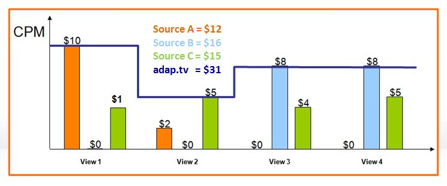
Death, taxes, and yield optimization: they’re all inescapable, and each one is about as pleasant as the others. There’s no denying that yield optimization is important, especially for online video ads, which now draw a vast amount of money industry-wide. Still, having your ad operations team spend the entire day looking at CPMs and ad sources is a miserable way to go about it—and even then, you’re probably still not capturing as much revenue or impression fill as you could be.
Consider “fixed daisy chaining,” the way many ad ops teams currently approach yield optimization. Day after day, the team studies ad sources including direct ad sales, ad networks, and other third party sources, and manually prioritizes them by CPM: Serve from Source A first; if that one defaults, try Source B; if that one defaults, try Source C, and so on. People do it this way because … well, because they’ve always done it this way. But how well does it really work? What if, right after you’ve set up your daisy chain, your sources change their pricing, and Source C now pays better than Source A? That sound you hear is potential revenue leaking from your pockets until you: 1. Discover that the pricing has changed, and 2. Reconfigure your daisy chain accordingly. In this sense, yield optimization becomes a matter of constant vigilance and endless manual work, and even then you’re still losing impressions and revenue while you scramble to keep up.
And it gets worse. Manual daisy chains might make you feel in control of your ad sources, but your ad server might have other ideas, rotating in lower-priced non-guaranteed ads to achieve a steady rate of delivery for the guaranteed ads sold by your direct sales force. Interruptions in your daisy chain can also disrupt impression tracking, so that some sources are tracked while others are missed.
So: inefficient, tiresome, and ineffective at actually optimizing yield … why are people still doing it this way, again?
Here’s a better approach: use a real time “second price” auction system to automatically fill at the highest available CPM across all video views. No matter how many ad sources default, you’re always assured of running the highest available CPM and fill for every impression. Instead of having to predict or project the average CPM value for a given impression, you capture the full value of your inventory in real time, every time. And because it happens automatically, your ad ops team can spend its time on higher-value matters like innovation and analysis, not manual drudgery.
This isn’t just a theoretical exercise—the newest breed of ad management platforms make it possible today. Let’s look at an example based on adap.tv onesource, a solution that automates yield optimization by streamlining ad source relationships for better revenue, impression fill, and operational efficiency. The chart below shows three ad sources—A, B, and C—all competing for four impressions/views.
Who do you choose to be first in every impression/view? How do you know it is the most optimal choice?
- If you choose ad source A to be the highest priority, making it first in your daisy chain, the maximum revenue will be $12, with fill at 50 percent.
- If ad source B is set as highest priority, the maximum revenue will be $16 and fill will be at 50 percent—achieving higher revenue, but doing nothing to lift a low fill rate.
- If ad source C is set as highest priority, the maximum revenue will be $15 and fill will be at 100 percent—generating less revenue, but achieving optimal fill.
Compare this with the automated yield optimization achieved by adap.tv onesource, which automatically selects the highest paying ad source for each impression/view using the real time “second price” auction system to fill at the highest available CPM across all video views. In this scenario, revenue is maximized at $31 with 100 percent fill—achieving both optimal revenue and optimal fill.
So: less work, better fill, and the most revenue possible. It’s simply a better way to do business—and it’s a lot more fun than death or taxes.
Editor’s Note: adap.tv is a sponsor of OPS taking place in NYC on September 30, 2010.